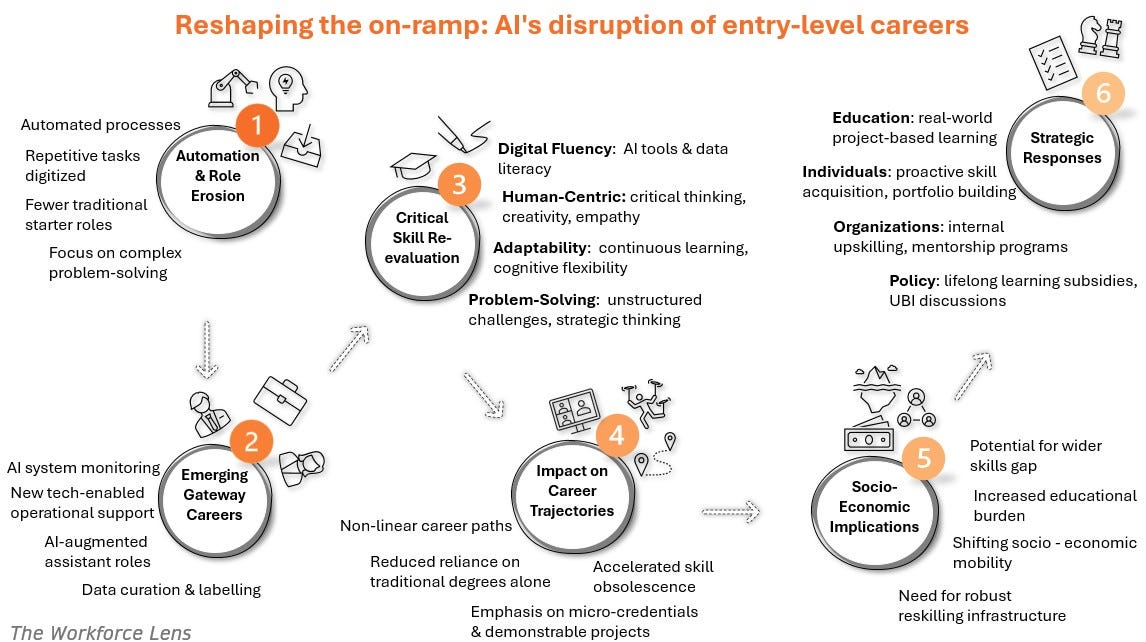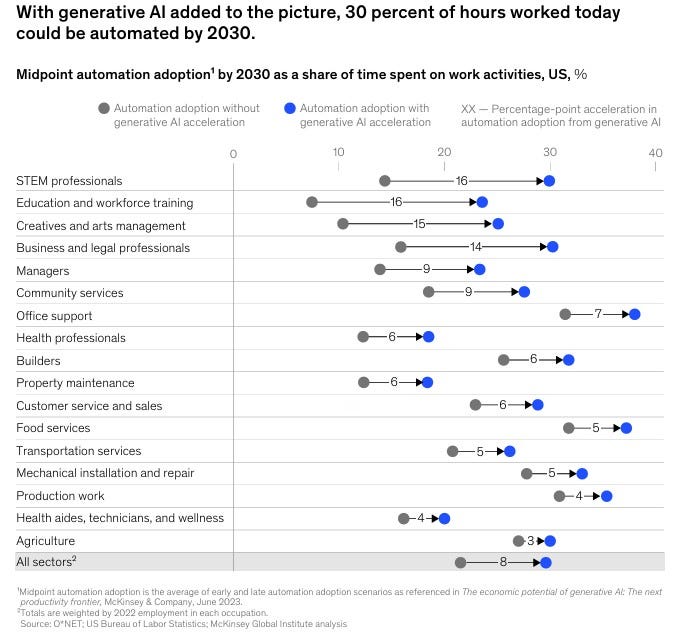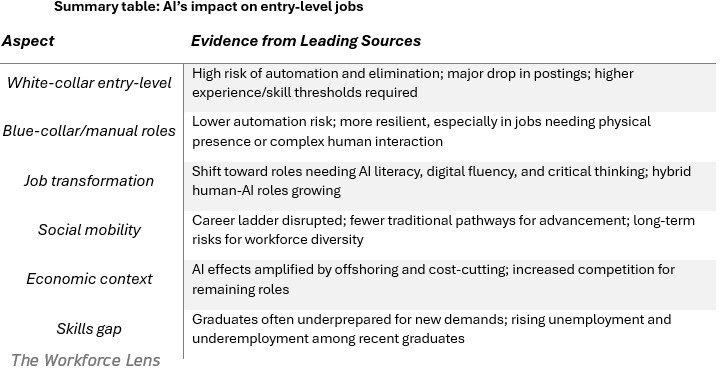How AI is reshaping entry-level careers: risks, skills, and strategies
A research-based guide to how AI is transforming entry-level white-collar jobs, what skills are now essential, and how to navigate the new world of early-career work
Dario Amodei, CEO of Anthropic, recently captured headlines with a stark warning: artificial intelligence could eliminate up to 50 percent of entry-level white-collar jobs within five years, potentially pushing unemployment to unprecedented levels. The idea of a rapid, quiet displacement has stirred debate and anxiety—but how much of this dire forecast, and its aggressive timeline, is supported by empirical evidence?
To move beyond speculation, I prioritised tangible research over opinions rather than relying on media narratives. I reviewed findings from established research institutions, including universities, consulting firms, and global think tanks. The emerging picture is not one of simple decline, but of structural change. While some roles are disappearing, many are evolving—demanding new skill sets and greater human-AI collaboration from the outset of a career.
What the data reveals is a more nuanced shift: a convergence of automation, economic strategy, and changing expectations around early-career work. Understanding this shift is critical not only for job seekers but also for employers, educators, and policymakers preparing for a very different kind of entry-level labour market.
What you will learn from this article:
How AI is already automating many routines, entry-level white-collar tasks—and why this trend is accelerating
Why most entry-level jobs are not simply disappearing, but are being transformed to require new skills and more human-AI collaboration
Which sectors and job types remain most resilient to automation, and why human skills still matter
How rising skill requirements and shrinking entry-level roles are making career starts harder for new graduates
What employers, educators, and policymakers need to do now to adapt hiring, training, and education for the AI era
Why it is relevant to HR?
The transformation of entry-level work driven by AI is reshaping how organizations attract, develop, and retain emerging talent. As automation reduces the number of traditional junior roles and raises the skill threshold for new hires, the established pathways for building future leadership and expertise are narrowing. This shift requires organizations to reconsider how they structure career entry points, design learning opportunities, and ensure a steady flow of qualified candidates for advancement. Failing to address these changes risks constricting the talent pipeline, widening skills gaps, and ultimately undermining long-term organizational resilience. Recognising and responding to this evolution is essential for any company aiming to sustain growth and competitiveness in an AI-driven economy.
Table of contents:
What research reveals about AI and entry-level white-collar jobs
How AI is transforming—not replacing—entry-level white-collar jobs
Why AI’s impact on entry-level jobs varies by sector and role
Beyond AI: economic and structural forces shrinking entry-level opportunities
The long-term impact: what fewer entry-level jobs mean for careers and companies
The big picture: what leading research says about AI and entry-level work
Key takeaways
Final thoughts: navigating entry-level careers in the age of AI
What is next
Further reading
I. What research reveals about AI and entry-level white-collar jobs
What was once a theoretical concern about the future of work has become a measurable shift in how organizations structure their entry points. AI adoption is no longer limited to isolated pilots or speculative forecasts—it is actively reshaping frontline roles across industries. Recent advances in generative AI and machine learning have allowed companies to automate tasks that were long considered the domain of early-career professionals.
The pace of this change is especially visible in white-collar environments, where routine and rule-based work has historically served as the foundation for entry-level employment. This automation effect is not just about efficiency; it is about redefining how companies value, recruit, and develop junior talent. Before we examine what types of jobs could disappear, it is worth understanding why the entry-level tier is bearing the impact of these changes.
Which entry-level white-collar jobs are disappearing—and why
The automation of entry-level white-collar jobs is no longer a theoretical risk—it is already underway. Tasks once handled by junior staff, such as data entry, basic customer support, and first-level analysis, are increasingly being absorbed by AI systems. These roles typically involve repetitive, codifiable tasks that can be easily standardized—exactly the type of work that large language models and automation tools are designed to perform.
For instance, AI-powered platforms can now extract insights from large datasets, draft reports, and respond to basic customer queries with speed and accuracy that often surpass human performance in routine, structured tasks.
However, these systems still struggle with tasks requiring contextual judgment, ambiguity management, or nuanced human interaction.
How far can AI automation go? Risks and limits for entry-level roles
As highlighted in McKinsey’s 2023 report Generative AI and the future of work in America, generative AI has the potential to automate tasks that currently account for up to 30 percent of all work hours performed across the entire US economy by 2030. This figure refers to the proportion of time spent on specific tasks, not the outright elimination of 30 percent of jobs, indicating a substantial shift in how work is divided between humans and machines rather than a direct loss of employment. As the report puts it:
“Generative AI has the potential to automate activities that absorb 60 to 70 percent of employees’ time today.”
— McKinsey, "Generative AI and the future of work in America" (2023)
Entry-level, routine office work is among the most exposed categories, making it especially vulnerable in this wave of transformation. The report notes that white-collar automation is accelerating faster than previously anticipated, with AI moving beyond physical tasks and into cognitive domains that were once considered safe. As McKinsey points out:
“Office support, customer service, and some entry-level professional roles are among the most exposed to automation by generative AI, with up to 30 percent of tasks potentially automated by 2030.”
— McKinsey, "Generative AI and the future of work in America" (2023)
McKinsey’s 2023 analysis estimates that generative AI has the technical potential to automate up to 30 percent of work hours by 2030, with routine entry-level office tasks among the most exposed. Importantly, this figure refers to task automation rather than complete job elimination, signalling that most roles will undergo significant transformation rather than disappearance. Entry-level positions characterised by predictable, rule-based tasks remain particularly susceptible to these changes, reflecting a broader shift in how AI is reshaping early-career work.
The true extent of automation risk remains debated: Earlier studies, such as the Oxford report, suggested that up to 47 percent of US jobs were at risk.
“According to our estimates, about 47 percent of total US employment is at risk.”
— Frey & Osborne, "The Future of Employment: How Susceptible are Jobs to Computerisation?" (2013)
However, recent task-based analysis from the National Bureau of Economic Research (NBER) reveals that when examining specific tasks rather than entire occupations, automation risk estimates decrease by as much as 60 percent. This finding indicates that most jobs will be restructured rather than eliminated. It reinforces the view that many roles comprise a mix of tasks, only some of which are susceptible to automation, making widespread, rapid job losses unlikely. As the NBER researchers summarise:
“We find that task-based approaches reduce automation risk estimates by approximately 60 percent compared to occupation-based methods.”
— NBER, "Large Language Models as Simulated Economic Agents: What Can We Learn from Homo Silicus?" (2023)
💡 Related read:
The AI index unveiled: how Artificial Intelligence is reshaping jobs and skills
See which jobs and skills are rising—or vanishing—right now as AI transforms the workplace. Get the real data and what it means for your career
II. How AI is transforming—not replacing—entry-level white-collar jobs
The narrative is not solely about disappearance; a parallel and equally significant trend is the transformation of roles that remain. Not all entry-level jobs are vanishing—some are undergoing a quiet but profound transformation. Rather than being eliminated outright, many roles are being redefined to focus less on repetitive execution and more on collaboration, judgment, and adaptability. This shift reflects a growing demand for human skills that complement rather than compete with AI.
New skills needed for entry-level jobs in the age of AI
As highlighted in both McKinsey's research and the World Economic Forum’s The Future of Jobs Report 2023, employers are increasingly seeking candidates who can work effectively alongside intelligent systems. Entry-level roles are now more likely to require critical thinking, problem-solving, and a baseline understanding of digital tools and automation. What used to be primarily execution-focused positions are evolving into hybrid roles that demand not only technical literacy but also the ability to apply human insight to machine-generated outputs.
These developments reinforce earlier findings on automation's task-based impact—the work may remain, but the shape of it is changing rapidly. This transformation means that early-career professionals are expected to bring a level of sophistication and agility that was not previously required at the start of one's career. While these roles are transforming rather than disappearing, it is worth questioning whether they still function as true 'entry points'. Elevated skill requirements raise barriers for candidates without prior experience—an issue explored in more depth later in this article.
Which sectors are most and least affected by AI in entry-level work
AI is primarily a job transformer, not just a job killer. AI is primarily a job transformer, not just a job killer. The World Economic Forum’s 2023 report projects that by 2027, 69 million new jobs will be created and 83 million eliminated—a net loss of 14 million jobs globally—but emphasizes that most roles will be transformed, not eliminated. The primary impact will be the transformation of job content, and the skills required, rather than widespread job loss. This shift underscores a broader trend towards redefining roles to incorporate new capabilities, while emphasising continuous upskilling and adaptation to evolving technologies.
III. Why AI’s impact on entry-level jobs varies by sector and role
The impact of AI is not distributed evenly across sectors or job types. While white-collar entry-level roles face mounting pressure, others remain relatively insulated—at least for now. Jobs that involve physical presence, hands-on tasks, or complex human interactions are proving more resistant to automation.
Human-centric entry-level jobs: where AI still struggles
According to Stanford HAI’s 2024 AI Index Report, jobs requiring physical presence, complex human interaction, or creative judgment—such as healthcare, education, and skilled trades—are currently the least affected by AI-driven automation. This means that the risk of automation is concentrated in certain domains, and any analysis of AI’s impact must take into account this uneven distribution of vulnerability. For instance, a nurse's role involves not just administering medication but also empathy, patient reassurance, and complex decision-making in unpredictable human interactions. Similarly, a plumber's work requires adapting to unique physical constraints of each installation, a level of improvisation and dexterity AI struggles with. As the Stanford report notes:
“Occupations that require physical work or interpersonal skills, such as healthcare, education, and skilled trades, remain less susceptible to automation.”
— Stanford HAI, "AI Index" (2024)
IV. Beyond AI: economic and structural forces shrinking entry-level opportunities
Importantly, AI is only part of the story. Broader structural and economic factors are also contributing to the decline of entry-level roles, sometimes more forcefully than automation itself. Economic uncertainty, global competition, and aggressive cost-cutting strategies are all reshaping hiring practices.
How offshoring and restructuring accelerate the decline of entry-level jobs
As McKinsey notes in Generative AI and the future of work in America, business restructuring and offshoring often accelerate the disappearance of traditional entry points. Companies seeking greater efficiency may choose to relocate entire functions overseas or restructure teams in ways that eliminate junior roles altogether. AI often supports or accelerates these choices, enabling firms to streamline operations even further.
In this context, the shrinking of entry-level opportunities reflects a combination of automation and broader strategic choices made by firms under pressure.
V. The long-term impact: what fewer entry-level jobs mean for careers and companies
The erosion of entry-level roles has implications that stretch well beyond individual companies. A sustained reduction in early-career opportunities risks weakening the entire talent pipeline. Without clear entry points, young professionals struggle to gain practical experience, develop foundational skills, and build the networks that support career progression.
How fewer entry-level jobs threaten career mobility and diversity
The World Economic Forum’s 2023 report warns that the reduction in entry-level opportunities could hinder social mobility and diversity, as fewer accessible pathways exist for early-career talent. When entry-level roles disappear or become inaccessible due to heightened skill requirements, the workforce risks becoming narrower and less inclusive. Crucially, eliminating these entry-level positions also removes vital learning and development opportunities that serve as the foundation for building mid-level talent. Without this essential stage for gaining practical experience and skills, organisations face a shrinking pool of qualified candidates for more senior roles. The report highlights this concern:
“The decline in entry-level roles risks narrowing the talent pipeline and limiting social mobility, as young workers face higher barriers to entry in the labor market.”
— World Economic Forum, "The Future of Jobs Report 2023"
The new pressure on education: preparing graduates for AI-driven jobs
This shift puts greater pressure on universities to equip graduates with more advanced, job-ready skills, while also increasing the importance of structured on-the-job learning programmes to bridge the gap. This paints a more complex picture than simple job elimination: what is being reshaped is not only the nature of work but the very architecture of career development itself.
VI. The big picture: what leading research says about AI and entry-level work
The evidence from diverse research sources paints a complex picture of how entry-level jobs are evolving in the age of AI and automation. Rather than a simple story of jobs disappearing, the reality involves a combination of job elimination, transformation, and varying sector-specific impacts. To unpack this, we examine three key perspectives: the mainstream consensus on automation’s effects, counterpoints highlighting resilient roles, and the growing skills gap between education and employer expectations. Together, these provide a layered understanding of the challenges and opportunities ahead.
The mainstream view: AI is transforming, not erasing, entry-level jobs
Most authoritative studies agree that artificial intelligence is not wiping out entry-level jobs wholesale, but it is significantly reducing the number of traditional, routine roles—especially in office-based environments. McKinsey’s Generative AI and the future of work in America report, for instance, underscores how generative AI is rapidly automating tasks historically assigned to junior staff, such as data entry, basic analysis, and customer support. This automation does not spell absolute elimination, but it does mean that many conventional entry points into professional work are disappearing or shrinking in scope.
This consensus points to a broader transformation in how entry-level talent is deployed. Rather than serving as a general support layer within organizations, these roles are increasingly expected to deliver higher-order thinking from the outset. The challenge is no longer just about filling junior positions—it is about redefining what those positions should entail in an AI-assisted workplace.
Counterpoints: roles and sectors resilient to AI disruption
Despite the pressure on white-collar roles, not all job categories are equally vulnerable. Research from Oxford and MIT provides a necessary counterbalance to AI-related fears, showing that many occupations requiring manual skills, physical presence, or complex human interaction remain relatively protected from automation. As confirmed by Stanford HAI, roles in healthcare, education, and maintenance remain less susceptible to automation due to their reliance on human judgment, dexterity, and interpersonal skills.
These findings emphasize the need to distinguish between job types. Automation risk is not evenly distributed, and blanket narratives about the “death” of entry-level jobs overlook these critical sectoral differences. For many roles, human presence, empathy, and situational judgment still matter deeply—and are not easily replicated by machines.
The widening skills gap: why entry-level candidates and employers are out of sync
A consistent theme across the research is the widening skills gap between what education systems provide and what employers now demand from entry-level talent. Surveys from McKinsey and the World Economic Forum suggest that many graduates feel ill-equipped for the demands of today’s job market, particularly in environments shaped by AI and digital systems. As McKinsey points out:
“Only 35 percent of employers believe new graduates are adequately prepared for the workforce, citing gaps in digital skills and adaptability.”
— McKinsey, "AI in the workplace: A report for 2025"
In The Future of Jobs Report 2023 2, the World Economic Forum warns that this disconnect is growing, creating friction between educational institutions and employers. While jobs are evolving, education is not always keeping pace—leaving young people underprepared just as expectations are rising. This misalignment is not simply about technical skills; it also involves critical thinking, adaptability, and the capacity to interpret and act on machine-generated outputs. As these capabilities become baseline requirements for entry-level work, the burden increasingly falls on individuals to bridge the gap themselves.
According to McKinsey’s 2024 survey, employers increasingly value digital literacy, project-based experience, and adaptability in new graduates, particularly for roles in analytics, operations, and product management.
“Employers are prioritizing digital literacy, analytical thinking, and adaptability when hiring for entry-level positions.”
— The state of AI in early 2024 | McKinsey
What employers, educators, and policymakers must do now
The “death” of entry-level jobs is not a myth—but neither is it an absolute truth. Research reveals a clear and accelerating trend: traditional pathways into white-collar work are becoming
narrower, more complex, and harder to access. Artificial intelligence is automating many of the foundational tasks that once defined junior positions, fundamentally shifting how careers begin.
This transformation demands a coordinated response across sectors. To ensure the evolving entry-level landscape remains accessible and equitable, key stakeholders must prioritise action:
Employers
Redesign entry-level roles to support learning, not just output
Invest in structured training, mentoring, and apprenticeships to close experience gaps
Rethink hiring criteria to value adaptability, digital literacy, and potential over prior experience
Educational institutions
Integrate real-world, AI-adjacent skills into core curricula (e.g. data literacy, critical thinking, human-AI collaboration)
Expand interdisciplinary and project-based learning to better simulate modern work environments
Partner with industry to co-create early talent pipelines that reflect evolving skill needs
Policymakers
Provide incentives for employers offering quality early-career programmes and apprenticeships
Support public-private initiatives that widen access to reskilling and upskilling
Address equity by ensuring underserved groups is not disproportionately excluded from the new economy
Debating the scale and pace: alternative views on AI’s impact on entry-level jobs
While Amodei's forecast suggests a rapid displacement within five years, much of the academic and consulting research, such as McKinsey's 2030 projections, tends to suggest a slightly longer adoption curve for widespread systemic impact. This discrepancy might arise from differing definitions of 'elimination' versus 'significant disruption,' or a focus on different phases of AI integration. A critical examination of the broader research reveals a more complex picture beyond just job numbers.
Public and expert scepticism: questioning the AI disruption narrative
Public opinion often diverges significantly from expert assessments regarding AI's impact. Surveys by Pew Research show that over 50% of Americans fear AI will hurt workers more than it will help, and a majority anticipate a major impact on jobs within two decades. However, studies from Brookings reveal that many AI experts and economists are more optimistic, believing AI will ultimately improve productivity and transform roles rather than solely eliminating them. Interestingly, Brookings also suggests that better-educated, higher-paid workers may be more exposed to AI-driven change, as their roles often involve sophisticated analytical tasks susceptible to automation. As Pew Research highlights:
“62% of Americans expect that AI will have a major impact on the workforce, but only 28% believe it will affect their own job.”
— Pew Research Center, "How the US Public and AI Experts View Artificial Intelligence" (2025)
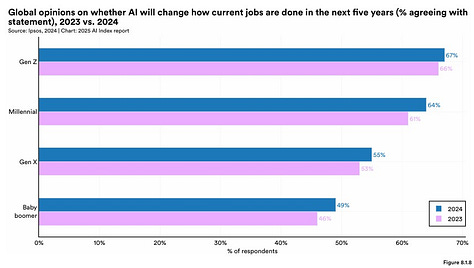
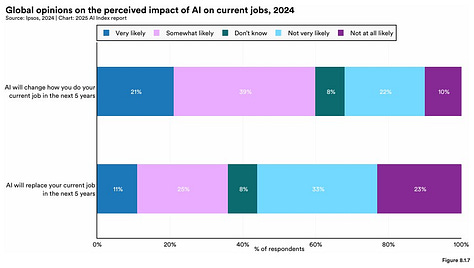
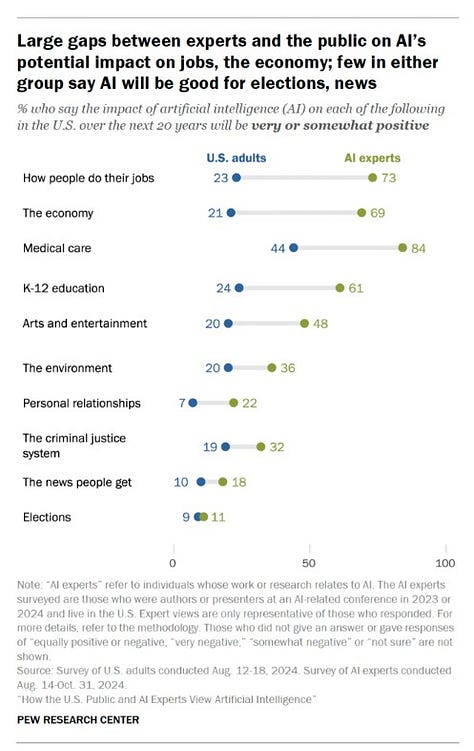
Caution: methodological limits and hype in AI and jobs research
Leading research organizations consistently warn that studies using occupation-based automation risk may overstate the threat of job loss. As highlighted by the OECD and ZEW, such studies often fail to account for the diverse range of tasks within jobs and the inherent adaptability of workers and organizations . They argue that the actual job loss will be far less than headline figures suggest, as most jobs will be restructured, not eliminated. Furthermore, despite rapid AI investment, McKinsey's latest workplace report indicates that only 1% of companies consider themselves "mature" in AI adoption, suggesting that the pace of large-scale displacement may be slower and less dramatic than some forecasts suggest.
Opportunity or exclusion? The rise of AI-native entry-level roles
While much attention focuses on the displacement and transformation of existing entry-level roles, AI is also creating entirely new categories of work. These emerging AI-native roles—such as prompt engineers, AI operations associates, or model validators—represent an important growth area in the labour market. However, a pressing question remains: will these new roles provide accessible pathways for early-career professionals, or will they demand advanced skills that exclude junior talent? Mercer’s Global Talent Trends 2024 report highlights this dilemma, noting that “AI is creating high-skill, high-responsibility roles faster than organisations can fill them—with few clear pathways for junior talent to step in.”
This suggests a paradox where AI expands the job market, yet often in ways that raise entry barriers rather than lower them. Academic research supports this complexity. The University of Maryland’s Smith School of Business developed tools tracking AI-related job postings and found a significant increase in demand for workers with AI and digital skills. While this growth in AI-skilled roles may offset some routine job losses, the entry requirements for these positions tend to be much higher, often requiring prior experience, hybrid technical-business fluency, or specialised education.
This reality contrasts with more familiar technological shifts, such as the invention of the calculator, which automated discrete tasks but generally elevated existing professions like accounting without drastically limiting access. Unlike calculators, generative AI reshapes entire job categories while spawning new roles with fundamentally different skill sets.
At the same time, these developments place increased pressure on education and training systems to create structured, supported pathways into these emerging roles. Without programmes such as apprenticeships, internships, or targeted upskilling, the risk is that early-career talent will be shut out, deepening existing inequalities in the labour market.
In sum, the rise of AI-native work presents both a remarkable opportunity and a serious challenge. Whether this wave leads to broader inclusion or entrenched exclusion depends on coordinated efforts among employers, educators, and policymakers to design accessible career pathways that prepare diverse talent for the evolving future of work.
Key takeaways:
AI is actively automating routine, entry-level white-collar tasks, fundamentally reshaping the structure and availability of junior roles
Most entry-level jobs are not disappearing entirely but are being redefined to demand advanced skills—critical thinking, digital literacy, and adaptability—from the outset
The impact of automation is uneven: jobs requiring human interaction, creativity, or physical presence (such as healthcare, education, and skilled trades) remain far less vulnerable
The erosion of traditional entry-level positions narrows career pathways, making it harder for new graduates to gain experience and for organizations to develop future leaders
A widening gap exists between what education provides and what employers now expect, leaving many young professionals underprepared for today’s AI-shaped job market
Structural and economic factors—like offshoring and business restructuring—are accelerating the decline of entry-level opportunities beyond automation alone
The loss and transformation of these roles threaten social mobility, diversity, and the long-term resilience of talent pipelines
Organizations that proactively redesign entry-level roles, invest in upskilling, and rethink
VII. Final thoughts: navigating entry-level careers in the age of AI
The idea that entry-level jobs are simply disappearing is not entirely accurate; rather, these roles are undergoing profound change. AI and automation are eliminating many traditional, routine tasks that once defined junior positions. However, many roles are transforming instead of vanishing, demanding a new set of skills centred on critical thinking, adaptability, and collaboration with intelligent systems.
This shift narrows the traditional entry points into white-collar careers, raising barriers for individuals without advanced skills or prior experience. Jobs requiring human judgement, empathy, and complex social interaction remain more resilient, though even these are evolving in response to technological progress.
This transformation presents urgent challenges for employers, educators, and policymakers. Organisations must rethink how they recruit, train, and develop early-career talent to ensure that these evolving roles remain accessible and meaningful. Educational institutions need to update curricula to prepare graduates for a digitally enhanced workplace. Policymakers must address equity and inclusion, ensuring no group is disproportionately excluded from the changing labour market.
Ultimately, the future of entry-level work is not about reversing automation but adapting intelligently and inclusively. The task ahead is to create pathways that allow all individuals to start and grow their careers in a rapidly evolving landscape.
But if traditional entry points vanish faster than we redesign them—who gets left behind, and who decides what a fair beginning looks like?'
What is next
The age of AI in HR is not approaching—it has already begun. But automating tasks is only the surface. What happens when algorithms influence hiring decisions, reshape team dynamics, and quietly redefine what it means to lead? The next article draws on global research to explore how HR can prepare—not just technologically, but structurally, ethically, and culturally. What foundations need to be in place before the first system goes live? What must HR protect, rebuild, or let go of to lead responsibly in a machine-augmented workplace? The question is no longer if you are ready, but what happens if you are not?
Further reading:
If you want to understand how technology is redefining the human side of HR “The empathy engine: choosing what to automate—and what to keep human in HR” examines how organisations are balancing automation with empathy, and why this balance is essential for employee engagement and effective learning. This article provides insight into the strategic decisions behind what should remain human in an increasingly automated workplace.
For a broader view on how external forces shape the labour market, “Europe’s workforce shift: how demographics are reshaping talent and HR” analyses how changing demographics are influencing talent needs and HR strategies across the continent. This piece offers valuable context for understanding how societal trends interact with technological change to reshape entry-level opportunities.
If you are seeking practical approaches to workforce transformation, “Future-proof your workforce: how strategic upskilling and reskilling drive business success” details how organisations can stay competitive by investing in continuous learning. This article highlights why upskilling and reskilling are now critical for both employers and employees navigating rapid technological evolution.
Readers favourites:
Remote Work Laws You Cannot Ignore: A Global Guide to Compliance
Remote Work in Transition: Benefits, Challenges, and Employee Preferences
The “Great Resignation” in Europe: What really happened and what is next?
References
Oxford, "The Future of Employment: How Susceptible are Jobs to Computerisation?"
Anthropic CEO warns of mass job losses from AI | Digital Watch Observatory
Generative AI and jobs: A 2025 update | International Labour Organization
Smith School Revolutionizes AI Job Tracking with AI-Powered Tool | Smith School
Artificial intelligence and jobs: No signs of slowing labour demand (yet) | OECD
Large Language Models as Simulated Economic Agents: What Can We Learn from Homo Silicus? | NBER
AI Job Growth includes ChatGPT-Fueled Surge Amid Overall Employment Slowdowns | Newswise
How the US Public and AI Experts View Artificial Intelligence | Pew Research Center




